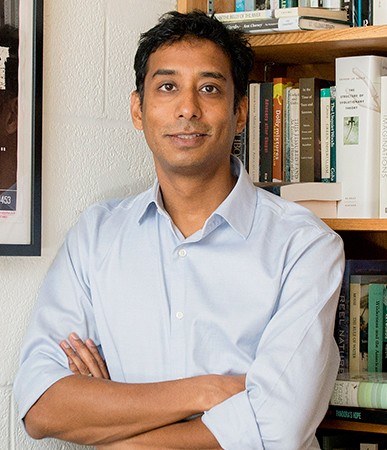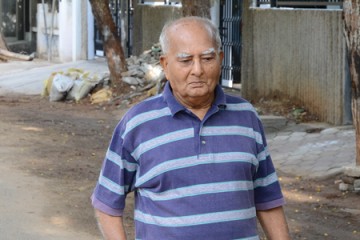Six years of fieldwork among filmmakers in India left an indelible impression on Anand Pandian.

Image caption: Anand Pandian
At first the Johns Hopkins associate professor of anthropology plunged into the Tamil film industry—a sector of India's giant film industry that the online magazine The Quint says is on the rise—to investigate how cinema shapes Indians' understanding of the rural world in southern India. As he discussed in the Johns Hopkins Magazine profile of this project, Pandian began to see a relationship between the collaborative social act of filmmaking and the collaborative social act of knowledge construction, a feedback loop between how we see the world and how we represent the world we see.
Duke University Press recently released Reel World: An Anthropology of Creation, the book that came out of that fieldwork. It is, in many ways, an experimental form of ethnography: Pandian uses literary fiction devices and narrative ideas borrowed from film language to present his exploration of the artists and skilled technicians in the act of creating a film. The book is the latest instance of Pandian balancing his storytelling gifts with an anthropologist's calm questioning of everything we think we know about the world.
In last year's Ayya's Accounts: A Ledger of Hope in Modern India—which follows Pandian's grandfather's 1,700-mile journey from Burma back to southern India during World War II—Pandian offers his grandfather's story as an example of how one person's life can contain nearly a century of sweeping history in miniature. Earlier this year, in an essay titled "The Ecology of What We Write" that appeared at the anthropology blog Savage Minds, Pandian reflected on the writing as a wonderfully imperfect distillation of lived experience. This meditative streak runs deeply through Reel World, an ethnography that at times reads like a perspective-shifting Richard Powers novel, steeped with information and philosophy.
The Hub caught up with Pandian—who will talk about his new book Thursday at the JHU-MICA Film Centre—by email to talk about the how studying film changes the way we consume movies, the attempt to write words that feel like cinema, and, in one word, plastics.
I've been on film sets before as a journalist, and there's a certain amount of demystification of movie magic when you see all the many boring things that go into it—the old saw about not wanting to see how the sausage is made. You dove into the Tamil film industry specifically to study how the sausage is made. How has the research and writing process changed how you see a movie—or has it?
It has, most definitely. I can't watch a film now without noticing little elements I never noticed before: the sweep of a camera, some object on the edge of a frame, the syncopation of a beat with what is happening visually on the screen. It's hard to shake a sense of all the labor that must have gone into what seems to unfold so seamlessly. You're right, of course, that seeing this come together so fitfully on a film set or in a studio can be excruciating, the glacial pace of things and the minute scale of corrections and adjustments. But this fieldwork, over time, became a kind of attunement to the significance of such minor events, to the value of what becomes visible when you slow down and focus more closely on what is barely perceptible. It got to the point that it began to seem like there was always too much happening, not too little. And that, unlike sausage, maybe, makes film more palatable, not less.
I want to ask you the question that, in the book, you write that people routinely asked you during your fieldwork: When are you going to make your own film? In the book you talk about the relationship between text and moving images as media for information, which informed the polyphonous, literary writing approaches you use in the book. Now that the book is done, what are your thoughts about film/video as an ethnographic vehicle, and would you ever consider using it as the vehicle for your work?
It's funny you ask, because I'm just back from the annual conference of the American Anthropological Association, where I presented something that seemed to go well, although no one knew exactly what to call it—"Your, ahem, intervention was quite interesting ... ." It was a sort of prose poem written as an accompaniment to some video footage I caught on my phone one afternoon by chance on St. Paul Street in Mount Vernon. I won't pretend that this was anything more than a little exercise, but I'm intrigued by the essay film as a genre of expression, and hope to explore this further in the future. More to the point of what you're asking, though, the writing of this book forced a change in my own language and habits of description. It forced me to collapse a familiar, and in some ways safer, distance between myself as an observer and the things I saw and wound up writing about. I began thinking a lot more about the force of image, movement, and rhythm in scholarly writing, on the sensory powers we mobilize when we write and the unexpected things that they can do for our thinking. This is something, I think, that will stay with me.
Let's talk about the writing briefly: you turn to a number of different voices, moods, narrative approaches in Reel World. Which was the most difficult to pull off? Are there any individual chapters where you feel like the subject matter, narrative approach, and thematic concerns produced an argumentative result that more traditional anthropological text might not have been able to achieve? (The "Speed" chapter on editing, for me, is particularly effective in discussing an understanding of time that is difficult to pull off in more conventional prose.)
I never had a particular conceit in mind at the outset of any of these chapters (actually, that's not quite true—early on I was possessed by the idea of writing the whole book in second-person narrative voice but luckily I was disabused of that idea). The narrative experiments evolved in each case as means of expressing, as concretely as possible, in the body of the writing, what each chapter was trying to argue. By far the most challenging of these was the chapter on desire, which, as you know, ultimately took shape as a single rather breathless sentence of 2,500 words, 410 commas, and just one period. I reworked this many times over, even down to the wire at the page proofs stage, and still don't know if it works. I wanted to say something here about the proximity of desire and madness in cinema, about the affective force of a certain kind of wanting that could dissolve the coherence of a stable identity. It struck me that the writing could itself embody this sense of excess and imbalance that one often finds in creative process, a stream of words as continuous exhalation, as the expression of a scream. Whether readers will tear their hair out, we will see.
I read a few chapters of this text when writing the profile of the project; now that I've read the book in full, what I admire about it is that it's in many ways a philosophical ethnography of creative labor: a consideration of the role of art in how we look at things and reproduce what we think we know about what we see, in the understanding of and creation of reality. I also get the impression that this aspect of the project was hard to wrangle, given that you were working with so many different points of view: cinematographers, actors, directors, writers, composers, editors, all the various technicians and artisans who collaborate to make a film. Were there any people in the filmmaking process you didn't get a chance to study?
Absolutely. There were so many actors in the process that the fieldwork and the book could not reach. What drew me to cinema was that its making was so complex, variegated, so densely social and material in its collaborations and infrastructures. Imagine trying to write a sustained ethnographic study of the creative process of an individual writer or a studio artist—how could you avoid getting in the way, or being an impossible distraction or irritation? Here, on the contrary, there were ever so many things happening at once, scattered throughout countless milieus of artisanal craftsmanship. I did my best, with the book, to try to convey this range, but there were certain aspects that were difficult to contend with: the industry's own elevation of creative figureheads and adepts over apprentices and laborers, for example, to the point where I really had to struggle to widen the perspective on filmmaking agency. I also tried to convey the significance in creative work of environmental forces and accidental circumstances of various kinds, which again, almost by nature, tend to escape our grasp. But the endeavor overall was to present something like an "ecology" of creative process, and my hope is that this has been set out widely enough in the book that readers could intuit such gaps on their own.
Where has this work taken you? What new questions has this project opened up for you?
I fell into this milieu of filmmaking almost by accident myself, as the core of my concerns have always been with ecological anthropology and anthropological approaches to environmental ethics. I was first drawn to cinema when I saw how deeply its images and affects had come to shape the experience of rural environments in contemporary south India. But now, having done this work, I can see how an underlying theme persists throughout the books I've worked on: the possibility of an openness or attunement to the vital potential of the worlds in which we find ourselves, possible ways of accommodating the pulse of circumstances beyond our control, as I saw time and again with these filmmakers, that we might even take as ethical orientations. With the grave ecological challenges of our time, so much seems to turn on our ability to learn new ways of relating to the world at hand, of changing ourselves in consonance with the dynamic flux of things rather than remaining hell-bent on mastering nature's contingencies. One name for this capacity is plasticity, and what I hope to do next is to think more about ethical malleability or plasticity in relation to the materials that bear this promise like no other: plastics. Celluloid, of course, was one of the earliest synthetic plastics, and I suspect therefore that this filmic substrate will continue to have a place in my research. I also suspect that this next project will have a practical, somehow material dimension to it, but that will depend a lot on the collaborative possibilities that surface in the years ahead.
Tagged anthropology, film, anand pandian









